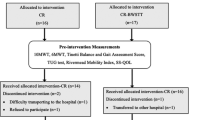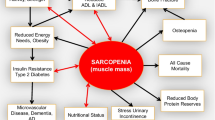Abstract
We investigated the incidence of disability and its risk factors in older Japanese adults to establish an evidence-based disability prevention strategy for this population. For this purpose, we used data from the Longitudinal Cohorts of Motor System Organ (LOCOMO) study, initiated in 2008 to integrate information from cohorts in nine communities across Japan: Tokyo (two regions), Wakayama (two regions), Hiroshima, Niigata, Mie, Akita, and Gunma prefectures. We examined the annual occurrence of disability from 8,454 individuals (2,705 men and 5,749 women) aged ≥65 years. The estimated incidence of disability was 3.58/100 person-years (p-y) (men: 3.17/100 p-y; women: 3.78/100 p-y). To determine factors associated with disability, Cox’s proportional hazard model was used, with the occurrence of disability as an objective variable and age (+1 year), gender (vs. women), body build (0: normal/overweight range, BMI 18.5–27.5 kg/m2; 1: emaciation, BMI <18.5 kg/m2; 2: obesity, BMI >27.5 kg/m2), and regional differences (0: rural areas including Wakayama, Niigata, Mie, Akita, and Gunma vs. 1: urban areas including Tokyo and Hiroshima) as explanatory variables. Age, body build, and regional difference significantly influenced the occurrence of disability (age, +1 year: hazard ratio 1.13, 95 % confidence interval 1.12–1.15, p < 0.001; body build, vs. emaciation: 1.24, 1.01–1.53, p = 0.041; body build, vs. obesity: 1.36, 1.08–1.71, p = 0.009; residence, vs. living in rural areas: 1.59, 1.37–1.85, p < 0.001). We concluded that higher age, both emaciation and obesity, and living in rural areas would be risk factors for the occurrence of disability.


Similar content being viewed by others
References
Statistical Bureau, Ministry of Internal Affairs and Communication. Population Count based on the 2010 Census Released. http://www.stat.go.jp/english/data/kokusei/pdf/20111026.pdf. Accessed 26 Feb 2014
National Institute of Population and Society Research (2012) Population projections for Japan (January 2012): 2011–2060. http://www.ipss.go.jp/site-ad/index_english/esuikei/ppfj2012.pdf. Accessed 26 Feb 2014
Long-Term Care Insurance Act. http://www.japaneselawtranslation.go.jp/law/detail_main?id=94&vm=4&re=. Accessed 26 Feb 2014
Ministry of Health, Labour and Welfare (2010) Outline of the results of National Livelihood Survey. http://www.mhlw.go.jp/toukei/saikin/hw/k-tyosa/k-tyosa10/4-2.html. Accessed 26 Feb 2014 (in Japanese)
Yoshimura N, Nakamura K, Akune T, Fujiwara S, Shimizu Y, Yoshida H, Omori G, Sudo N, Nishiwaki Y, Yoshida M, Shimokata H (2013) The longitudinal cohorts of motor system organ (LOCOMO) study. Nippon Rinsho 71:642–645 (in Japanese)
Ministry of Health, Labour and Welfare. Long-term care insurance in Japan. http://www.mhlw.go.jp/english/topics/elderly/care/index.html. Accessed 26 Feb 2014
WHO Expert Consultation (2004) Appropriate body-mass index for Asian populations and its implications for policy and intervention strategies. Lancet 363:157–163
Zheng W, McLerran DF, Rolland B, Zhang X, Inoue M et al (2011) Association between body-mass index and risk of death in more than 1 million Asians. N Engl J Med 364:719–729
Whitlock G, Lewington S, Sherliker P, Clarke R, Emberson J, Halsey J, Qizilbash N, Collins R, Peto R, Prospective Studies Collaboration (2009) Body-mass index and cause-specific mortality in 900,000 adults: collaborative analyses of 57 prospective studies. Lancet 373:1083–1096
Haslam DW, James WP (2005) Obesity. Lancet 366:1197–1209
Felson DT, Anderson JJ, Naimark A, Walker WM, Meenan RF (1988) Obesity and knee osteoarthritis: the Framingham study. Ann Intern Med 109:18–24
Hart DJ, Spector TD (1993) The relationship of obesity, fat distribution and osteoarthritis in the general population: the Chingford study. J Rheumatol 20:331–335
Van Saase JL, Vandenbroucke JP, Van Romunde LK, Valkenburg HA (1998) Osteoarthritis and obesity in the general population. A relationship calling for an explanation. J Rheumatol 15:1152–1158
Magliano M (2008) Obesity and arthritis. Menopause Int 14:149–154
Zhang W, Moskowitz RW, Nuki G, Abramson S, Altman RD, Arden N et al (2008) OARSI recommendations for the management of hip and knee osteoarthritis, part II: OARSI evidence-based, expert consensus guidelines. Osteoarthr Cartil 16:137–162
Muraki S, Akune T, Oka H, Mabuchi A, En-yo Y, Yoshida M et al (2009) Association of occupational activity with radiographic knee osteoarthritis and lumbar spondylosis in elderly patients of population-based cohorts: a large-scale population-based study. Arthr Rheum 61:779–786
Lohmander LS, Gerhardsson de Verdier M, Rollof J, Nilsson PM, Engstrom G (2009) Incidence of severe knee and hip osteoarthritis in relation to different measures of body mass: a population-based prospective cohort study. Ann Rheum Dis 68:490–496
Yoshimura N, Muraki S, Oka H, Kawaguchi H, Nakamura K, Akune T (2011) Association of knee osteoarthritis with the accumulation of metabolic risk factors such as overweight, hypertension, dyslipidaemia, and impaired glucose tolerance in Japanese men and women: the ROAD study. J Rheumtol 38:921–930
Yoshimura N, Muraki S, Oka H, Tanaka S, Kawaguchi H, Nakamura K, Akune T (2012) Accumulation of metabolic risk factors such as overweight, hypertension, dyslipidaemia, and impaired glucose tolerance raises the risk of occurrence and progression of knee osteoarthritis: a 3-year follow-up of the ROAD study. Osteoarthr Cartil 20:1217–1226
De Laet C, Kanis JA, Odén A, Johanson H, Johnell O, Delmas P, Eisman JA, Kroger H, Fujiwara S, Garnero P, McCloskey EV, Mellstrom D, Melton LJ 3rd, Meunier PJ, Pols HA, Reeve J, Silman A, Tenenhouse A (2005) Body mass index as a predictor of fracture risk: a meta-analysis. Osteoporos Int 16:1330–1338
Kobayashi T (2011) The relationship between variation in the requirement certification rate in prefectures and nursing care level in long-term care insurance. Otsuma Women’s Univ Bull Fac Hum Relat 13:117–128 (in Japanese)
Shimitutani S, Inakura N (2007) Japan’s public long-term care insurance and the financial condition of insurers: evidence from municipality-level data. Gov Audit Rev 14:27–40
Nakamura H (2006) Effect of received condition of long-term care insurance on the regional difference of the certification rate of the disability. J Health Welf Stat 53:1–7 (in Japanese)
Yoshimura N, Muraki S, Oka H, Mabuchi A, En-Yo Y, Yoshida M, Saika A, Yoshida H, Suzuki T, Yamamoto S, Ishibashi H, Kawaguchi H, Nakamura K, Akune T (2009) Prevalence of knee osteoarthritis, lumbar spondylosis and osteoporosis in Japanese men and women: the research on osteoarthritis/osteoporosis against disability study. J Bone Miner Metab 27:620–628
Orimo H, Hashimoto T, Sakata K, Yoshimura N, Suzuki T, Hosoi T (2000) Trends in the incidence of hip fracture in Japan, 1987–1997: the third nationwide survey. J Bone Miner Metab 18:126–131
Yoshimura N, Suzuki T, Hosoi T, Orimo H (2005) Epidemiology of hip fracture in Japan: incidence and risk factors. J Bone Miner Metab 23:78–80
Orimo H, Yaegashi Y, Onoda T, Fukushima Y, Hosoi T, Sakata K (2009) Hip fracture incidence in Japan: estimates of new patients in 2007 and 20-year trends. Arch Osteoporos 4:71–77
Ueshima H, Ohsaka T, Asakura S (1986) Regional differences in stroke mortality and alcohol consumption in Japan. Stroke 17:19–24
Acknowledgments
This work was supported by grants from Grant-in-Aid for H17-Men-eki-009 (Director, Kozo Nakamura), H20-Choujyu-009 (Director, Noriko Yoshimura), H23-Choujyu-002 (Director, Toru Akune), and H-25-Chojyu-007 (Director, Noriko Yoshimura) of the Ministry of Health, Labour and Welfare. Further grants were provided by Scientific Research B24659317, B23390172, B20390182, and Challenging Exploratory Research 24659317 to Noriko Yoshimura; B23390357 and C20591737 to Toru Akune; B23390356, C20591774, and Challenging Exploratory Research 23659580 to Shigeyuki Muraki; Challenging Exploratory Research 24659666, 21659349, and Young Scientists A18689031 to Hiroyuki Oka, and collaborative research with NSF 08033011-00262 (Director, Noriko Yoshimura) from the Ministry of Education, Culture, Sports, Science and Technology in Japan. The sponsors did not contribute to the study design, data collection, data analysis, data interpretation, or the writing of the manuscript.
The authors wish to thank Ms. Kyoko Yoshimura, Mrs. Toki Sakurai, and Mrs. Saeko Sahara for their assistance with data consolidation and administration.
Conflict of interest
All authors declare no conflicts of interest.
Author information
Authors and Affiliations
Corresponding author
About this article
Cite this article
Yoshimura, N., Akune, T., Fujiwara, S. et al. Incidence of disability and its associated factors in Japanese men and women: the Longitudinal Cohorts of Motor System Organ (LOCOMO) study. J Bone Miner Metab 33, 186–191 (2015). https://doi.org/10.1007/s00774-014-0573-y
Received:
Accepted:
Published:
Issue Date:
DOI: https://doi.org/10.1007/s00774-014-0573-y




